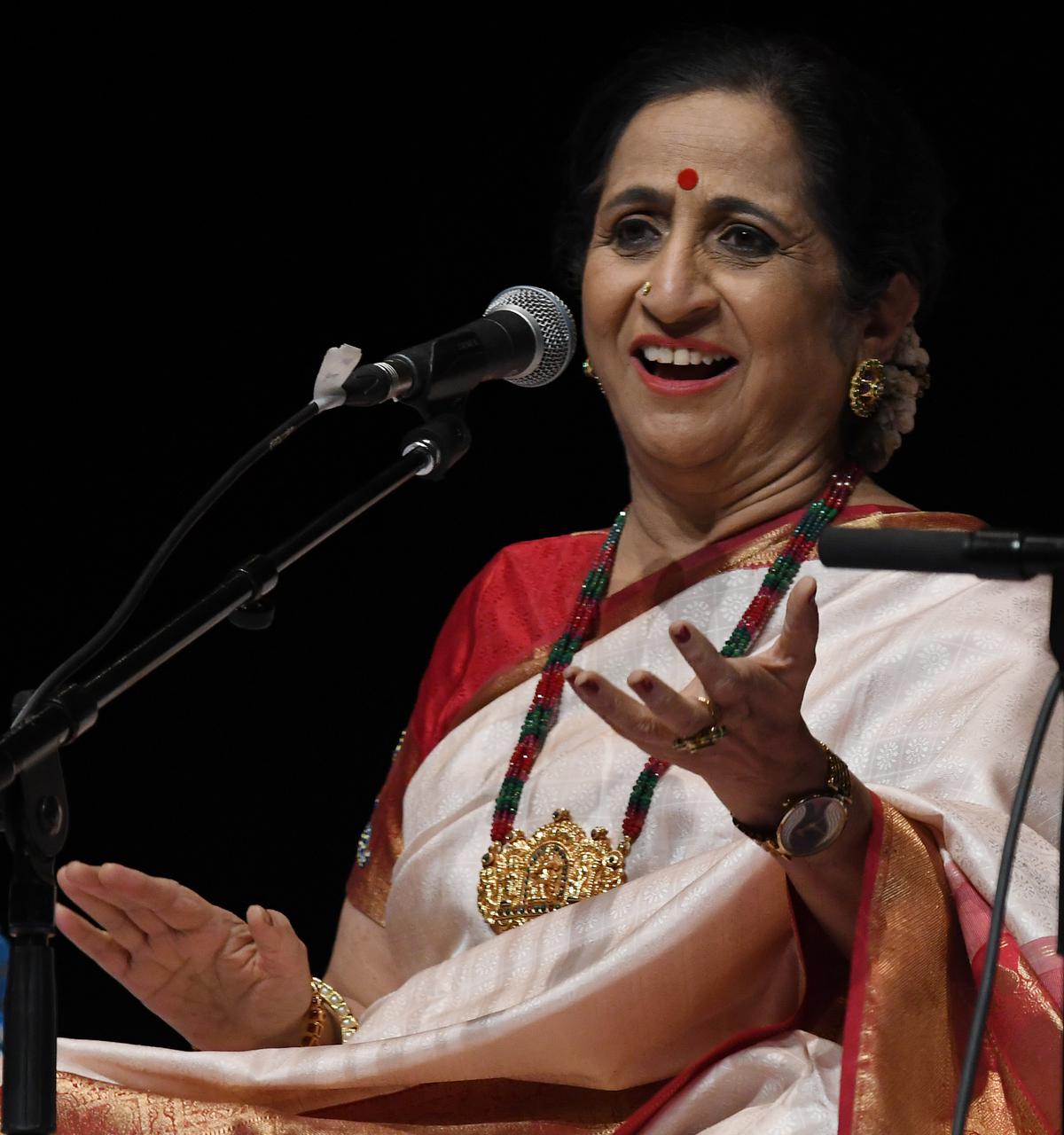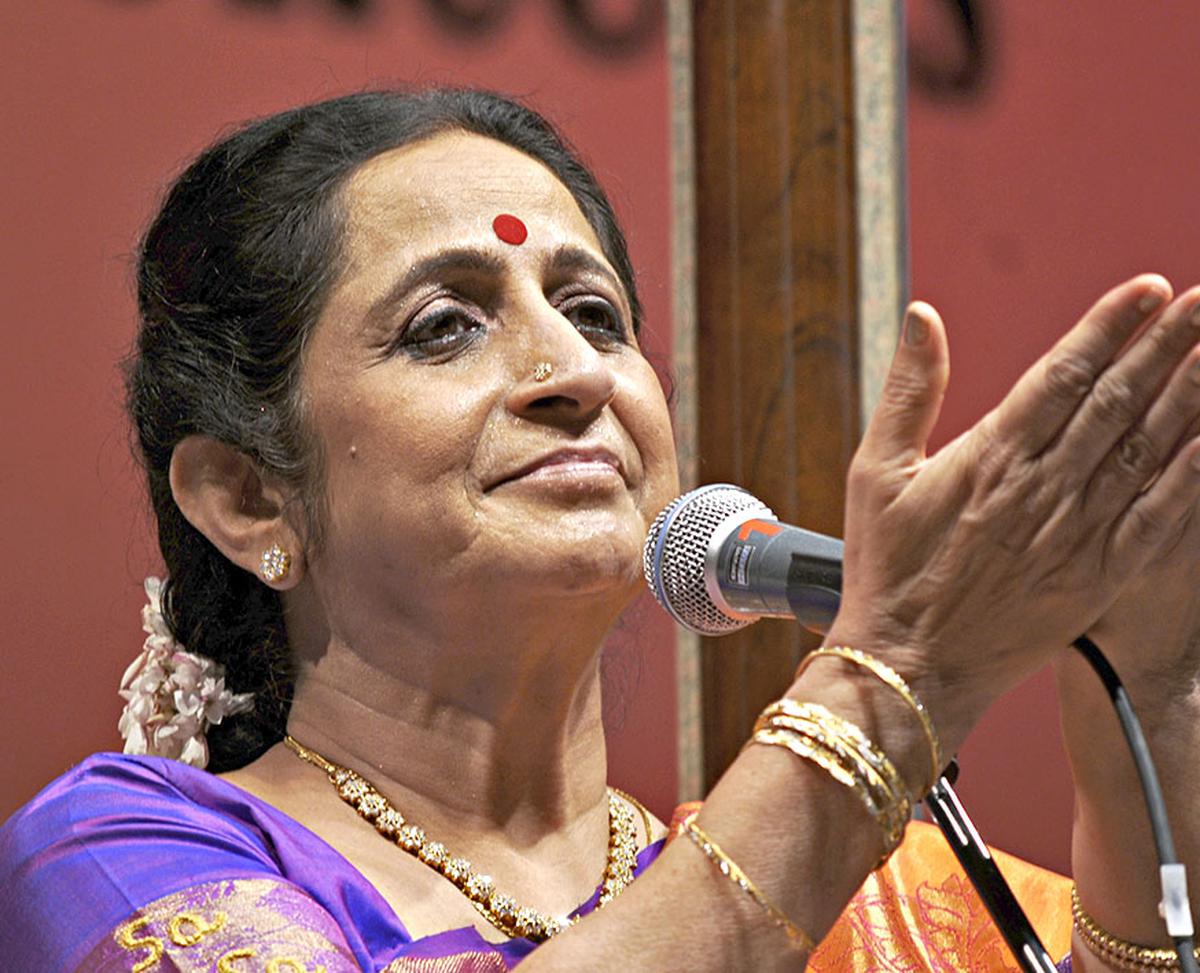
Aruna Sairam, Padma Shankar, J. Vaidyanathan, and Apurba Mukherjee at the
| Photo Credit: Special Arrangement
The setting was regal — a baithak on Azimganj House Rooftop in Kolkata. The singer was Aruna Sairam. The concert was part of Bickram Ghosh’s Taal Connect series and hosted by Suman Sarawgi and Sangeeta Dudhoria.
An engaging performer and a warm conversationalist, the Carnatic exponent developed an instant connect with the audience with her multilingual renditions, which were both educative and entertaining.
The word edu-tainment is a recent coinage, but this had always been the main component of ancient teaching methodology. Sangeet (inclusive of vocal, instrumental and dance) and natak (drama) play a vital role in educating keen students and uninformed masses. Its oldest form was saam-gaan, followed by marg sangeet and natya along with numerous desi genres. The medieval India did this through compositions by saint-poets, Kathakata (Kathak) or enactment of Ramleela etc.
Aruna Sairam keeps expanding her song repertoire.
| Photo Credit:
Velankanni Raj
It is more relevant today because of the need for holistic knowledge. Indian music is high in demand due to its scientific, philosophic and mythical appeal and above all its calming effect. This global interest in Indian arts has unearthed numerous edu-tainers like Aruna Sairam.
Aruna began her concert with ‘Shree Vighnarajam Bhaje’ (Gambhira Natai, khanda nadai). The flawlessly chiseled Sanskrit lyrics, embellished with swaraprastaras, ended with a tihai of ‘bhaje’. Her learned accompanists were Padma Shankar and J. Vaidyanathan on the violin and mridangam respectively. The inclusion of senior tabla artiste Apurba Mukherjee was a clear indication that Aruna was in a collaborative mood.

Aruna Sairam tailors her concerts according to the audience and venue.
| Photo Credit:
V.V. Krishnan
She chose Hindolam (Malkauns in Hindustani parlance) to elaborate the popular ‘Sarva mangala maangalye’, extoling Durga. The powerful raga and her equally commanding voice-throw gelled well with this pranaam mantra — free from any binding tala cycle. It was followed by Adi-tala based ‘Maamavatu shree Saraswati’ replete with jati-display, sol-fa-singing in a dialogue form that interacted with mridangam and tabla one by one and then all of them together. The idea of using aroh-avaroha as the ground of rhythm-play was well-executed by all. A small piece on the tabla stood out for the variety of bols used.

Aruna Sairam enjoys the best of both worlds – Carnatic and Hindustani.
| Photo Credit:
Special Arrangement
This typically Carnatic beginning took an interesting turn when she sang ‘Neelambike maam paahi’ beseeching Devi Meenakshi to protect; but not before singing an Italian chant exalting mother that sounded like raga Kalyani (Yaman). The anecdote associated with the chant was as emotive as the original Gregorian chant. Later she lovingly blended both at her own pace. The next piece was a pictorial description of Ganapati visarjana in Marathi that captured Mumbai’s frenzy in fast Adi-tala and Vrindavani Sarang based song along with heavy gamak-induced vowel taans. An English band-influenced raga (Kadana Kutuhalam) and its composition maintaining the typical off beat beginning and ending of Western music was her next gem. In fast Adi tala her rhythm play during swaraprastara was lively.
Aruna judiciously edited her main piece in Kiravani. The ragam and a brief tanam segments were followed by violin beautifully. Caressed by her lyric-based improvisations and swaraprastatas, the pallavi unfurled itself petal by petal. The tani avartanam shared by mridangam and tabla was full of zing. Thereafter, in quick succession, she rendered an exuberant ‘Jago tumi jago’ (Bengali) and drew its similarity with Lalita Sahasranama and Mahishasurmardini. A tillana (16th century) was studded with a rap-like long kavitta describing Kaliya-mardana. Its modulation was as attractive as the presentation herself.
Stay connected with us on social media platform for instant update click here to join our Twitter, & Facebook
We are now on Telegram. Click here to join our channel (@TechiUpdate) and stay updated with the latest Technology headlines.
For all the latest Entertainment News Click Here
For the latest news and updates, follow us on Google News.
